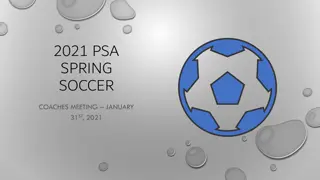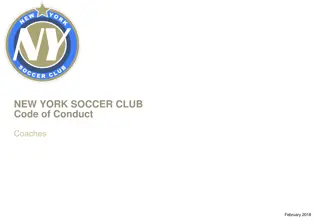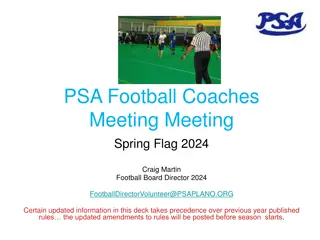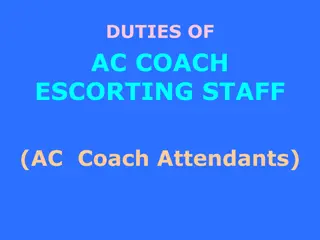Guidance for High School Coaches: Organize, Plan, and Succeed
Coaching a high school team comes with unique challenges and responsibilities, different from coaching club or summer league teams. This resource provides insightful advice on how to identify requirements, organize tasks, create team structures, and prepare for a successful season. By staying organized, dividing tasks effectively, and being proactive, high school coaches can navigate their roles with confidence and success.
Uploaded on Sep 12, 2024 | 4 Views
Download Presentation

Please find below an Image/Link to download the presentation.
The content on the website is provided AS IS for your information and personal use only. It may not be sold, licensed, or shared on other websites without obtaining consent from the author.If you encounter any issues during the download, it is possible that the publisher has removed the file from their server.
You are allowed to download the files provided on this website for personal or commercial use, subject to the condition that they are used lawfully. All files are the property of their respective owners.
The content on the website is provided AS IS for your information and personal use only. It may not be sold, licensed, or shared on other websites without obtaining consent from the author.
E N D
Presentation Transcript
Beyond the Pool: What High School Coaches Need to Know
New to Coaching High School? Coaching high school an entirely different list of expectations from coaching a club team or a summer league team. The information presented in this presentation will guide you through the many tasks that await you as a high school coach. Don t become overwhelmed. Don t be anxious. Relax and enjoy the experience. Coaching high school can be one of the most rewarding experiences you can have.
At the end of this presentation you should be able to: Identify state and school requirements Organize yourself to handle all of the tasks to be completed Create a framework for a Team Handbook Determine what training you may need to provide for team leaders, assistant coaches, and managers Prepare for a Parent/Athlete pre-season meeting Create a plan for the season Create evaluation materials to evaluate your season and yourself
Some helpful advice: Be ORGANIZED. It will save you many headaches. Plan ahead. You can never be too organized. Anticipate any potential challenges. Be certain of your responsibilities. Be aware of the school administration s expectations. Pay attention to details.
Divide and Conquer To insure that tasks are not overlooked and are completed on time, you might consider dividing them up into categories. You might divided them into: School, Swimmer, Parent Guidelines, Schedules, Paperwork Pre-season, In-season, Post-season
Once you have divided the tasks into categories, you can further divide them by grouping similar tasks together. For example: Paperwork, Meet Management, Equipment, etc.
Self-directed Assignment #1 Determine a method to divide the season s tasks. Write the categories down or enter them into your computer. Add tasks to each category as you move through the season. An example you might use follows.
Pre-season Paperwork School and District Level Meet schedule Coach or Athletic Director made? Transportation Forms Bus? Vans? Personal cars? Passengers? Additional forms for out-of-town or overnight? Who Schedules transportation? Academically Eligible? Most schools and state organizations have academic requirements. Physicals? Many state organizations require a physical before 1stday of practice Weather restrictions for practice There may be restrictions even for indoor practices Additional Paperwork may include: Substance Abuse Policies Pool Schedule/Reservations Fundraising Forms Schedules for Team Pictures, Team Dinners, Senior Banners, etc. Communication with local club coaches about shared athletes and training
Pre-season Paperwork Program Specific Team Handbook PUT IT IN WRITING Coaching philosophy Team rules and regulations Coach s expectations Tryout Criteria Lettering Policy Attendance Policy Practice and Meet Schedules Booster Club Responsibilities
Self-directed Assignment #2 Create a list of items to include in a Team Handbook. As you proceed through this presentation, add to your list of items to be included.
Pre-season Tasks Equipment, Uniforms and Technology Learn the meet and entry software Learn how to set up the timing system and check to make sure it is operational Check stopwatches and replace batteries as needed Inventory equipment and uniforms Order new equipment and uniforms as needed Update or create a team website
Pre-season Tasks Staff, Officials, and Team Leaders Secure your coaching staff and provide any training needed Schedule officials for home meets (you might need to update them on rules changes for the year) Meet with the leaders of team and provide leadership training as needed Select team managers and provided necessary training
Pre-season Tasks Rules and Regulations Obtain a NFHS rulebook and read it Become familiar with the specific regulations of your State Association concerning numbers of meets, state meet entries, state meet qualifications, etc.
Pre-season Tasks Parent/Athlete Meeting Schedule a meeting with the parents, swimmers and divers prior to the season. Discuss the Team Handbook, if you prepare one. Discuss expectations concerning attendance, sportsmanship, academics, the lettering policy, the requirements to make the team, practice and meet schedules, ways for parents to help, booster club responsibilities, district and school forms (including physicals)
Self-directed Assignment #3 Gather the materials necessary for a pre-season meeting with parents and athletes. Determine how you will present the material.
Season Planning Prepare a season plan for all aspects of training: dryland/weights program, training, goal setting and psychological training, and a teambuilding program.
Self-directed Assignment #4 Create a Season Plan Include all aspects of the program
In-season Paperwork Daily attendance, if your policy requires such Dismissal from class e-mails Announcements for meet results, team accomplishments, etc. Meet entries Meet information for home meets Heat sheets for home meets and other meet reports Team roster, once determined Order forms Maintain records dealing with meet results, school records, lettering Obtain USA Swimming sanctions for championship meets
In-season Tasks Confirm transportation schedule Communicate daily with your staff and provide training as needed Communicate with team managers on a daily basis about their responsibilities Prepare meet entries Set up pool equipment to host meets Maintain equipment Confirm schedule for officials Maintain communication with the parent booster club Train officials to run the timing system.
A Few Notes About In-season Communication Establish and maintain good communication with the divers and your diving coach. Establish and maintain good communication with your parent booster club. Keep your Athletic Director and his Administrative Assistant informed about what is happening with your program.
An Important Tip Develop a good relationship and keep good lines of communication open with other coaches and sponsors in your school. Be flexible with student expectations.
Make the Administrative Assistant and Custodians your friends. Treat them as equals. It pays off. Establish good communication with the person in charge of student recognition and student announcements. Know the office staff and custodians by name. They can be a great help to you throughout the season.
The College Recruitment Process Meet with appropriate swimmers and their parents concerning the college recruitment process Write e-mails or letters to college coaches, when appropriate Be knowledgeable about the Clearing House and NCAA rules and regulations
Tips for Hosting a High School Meet Learn how to set up the timing system. Test the system before the first meet. Teach your managers and/or swimmers how to set up and take down the equipment. Assign tasks to various groups of swimmers. Example: Juniors and Seniors timing system Freshmen and Sophomores chairs Train your managers how to run the software to hold your meet. If an official is late or absent a manager can assist. Allow plenty of time to set up the pool area for meets. You might arrange for cheerleaders or National Honor Society members to serve as timers for the meet.
Self-directed Assignment # 5 Create a list of things to do in order to host your home swimming meets. Make the list clear enough that anyone could pick it up and use it to set up a meet.
Post-Season Paperwork List of names who earned athletic letters to AD or AD s secretary Banquet program NISCA Power Points application NISCA Swimming and Diving All-America applications NISCA Scholar Team application NISCA Academic All- America applications Prepare season summary including All-State, All- Conference, All-America swimmers and divers for AD
Post-Season Tasks Collect equipment and uniforms from athletes Make sure equipment is securely stored away Prepare inventory list for AD and yourself Determine any needed repairs and submit list to the AD
Evaluations Meet with your coaching staff to evaluate their performances and to give them an opportunity to offer their suggestions and concerns. Meet with your AD to discuss your coach s evaluation. Assist swimmers and divers in their recruitment endeavors.
Evaluate the seasons schedule and begin to prepare next year s schedule Evaluate the team s performance for the season and determine what changes you, as a coach, need to make to your season plan.
Self-directed Assignment #6 Consider how you will evaluate your program and yourself at the end of the season. Create a framework for your evaluation.
Personal preparations for the next year Continue your professional education during the post-season. Be a student of the sport. READ RESEARCH LISTEN ASK QUESTIONS Join your professional organizations.























